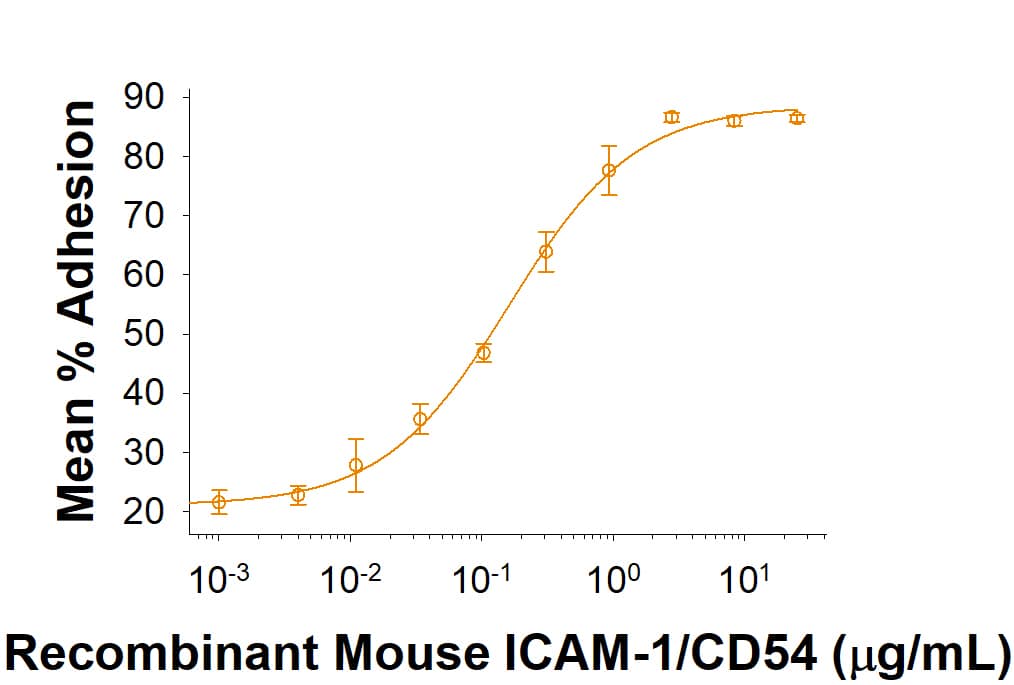Recombinant Mouse ICAM-1/CD54 His-tag Protein, CF
R&D Systems, part of Bio-Techne | Catalog # 10304-IC

Key Product Details
Product Specifications
Source
Mouse myeloma cell line, NS0-derived mouse ICAM-1/CD54 protein
Gln28-Asn485, with a C-terminal 6-His tag
Gln28-Asn485, with a C-terminal 6-His tag
Purity
>95%, by SDS-PAGE visualized with Silver Staining and quantitative densitometry by Coomassie® Blue Staining.
Endotoxin Level
<0.10 EU per 1 μg of the protein by the LAL method.
N-terminal Sequence Analysis
Gln28
Predicted Molecular Mass
51 kDa
SDS-PAGE
85-105 kDa, under reducing conditions
Activity
Measured by its ability to support the adhesion of HSB2 human peripheral blood acute lymphoblastic leukemia cells.
The ED50 for this effect is 0.075-0.6 µg/mL.
Scientific Data Images for Recombinant Mouse ICAM-1/CD54 His-tag Protein, CF
Recombinant Mouse ICAM-1/CD54 His-tag Protein Bioactivity
Recombinant Mouse ICAM-1/CD54 His-tag Protein (Catalog # 10304-IC) supports the adhesion of HSB2 human peripheral blood acute lymphoblastic leukemia cells. The ED50 for this effect is 0.075-0.6 μg/mL.Recombinant Mouse ICAM-1/CD54 His-tag Protein SDS-PAGE
2 μg/lane of Recombinant Mouse ICAM-1/CD54 His-tag (Catalog # 10304-IC) was resolved with SDS-PAGE under reducing (R) and non-reducing (NR) conditions and visualized by Coomassie® Blue staining, showing bands at 85-105 kDa.Formulation, Preparation and Storage
10304-IC
| Formulation | Lyophilized from a 0.2 μm filtered solution in PBS. |
| Reconstitution | Reconstitute at 500 μg/mL in PBS. |
| Shipping | The product is shipped with polar packs. Upon receipt, store it immediately at the temperature recommended below. |
| Stability & Storage | Use a manual defrost freezer and avoid repeated freeze-thaw cycles.
|
Background: ICAM-1/CD54
References
- Robledo, O. et al. (2003) Eur J Immunol. 33(5):1351.
- Springer, T.A. (1994) Cell. 76:301.
- Yang, L. et al. (2005) Blood. 106(2):584.
- Rosenstein, Y. et al. (1991) Nature 354:233.
- Pluskota, E. and S.E. D’Souza (2000) Eur. J. Biochem. 267:4693.
- McCourt, P.A.G. et al. (1994) J. Biol. Chem. 269:30081.
- Kirchberger, S. et al. (2006) Immunobiology 211:537.
- Chakravorty S.J. and A. Craig (2005) Eur J. Cell Biol. 84:15.
- Ding, Y. et al. (2019) Ann. Clin. Transl. Neurol. 6:945.
- Benson, V. et al. (2007) Curr. Mol. Med. 7:219.
- Hoogeveen, R.C. et al. (2007) Diabetologia 50:36.
- Covarrubias, M. et al. (2007) Am. J. Transplant. 7:2573.
- Cottone, S. et al. (2007) J. Hypertens. 25:423.
- Brake, D.K. et al. (2006) Am. J. Physiol. Cell Physiol. 291:C1232.
- Madej, A. et al. (2005) Pharmacol. Rep. 57:878.
- El-Gohary, A.M. et al. (2004) Egypt. J. Immunol. 11:109.
- Christiansen, I. et al. (1996) Br. J. Haematol. 92:639.
- Kang, X. et al. (2005) World J. Gastroenterol. 11:4250.
- Lei, A. et al. (2018) JEM. 215(8):2157.
Long Name
Intercellular Adhesion Molecule 1
Alternate Names
CD54, ICAM1
Gene Symbol
ICAM1
UniProt
Additional ICAM-1/CD54 Products
Product Documents for Recombinant Mouse ICAM-1/CD54 His-tag Protein, CF
Product Specific Notices for Recombinant Mouse ICAM-1/CD54 His-tag Protein, CF
For research use only
